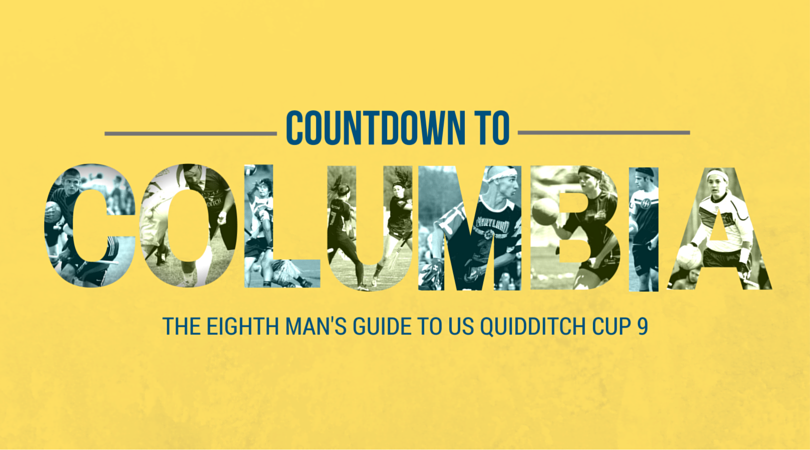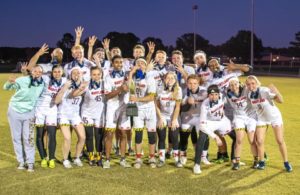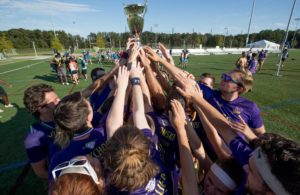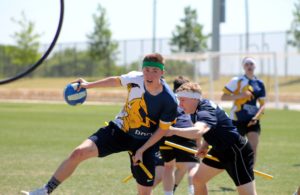- Rule, Britannia, no more?
- Unpopular Opinions: US Quadball Cup 2023
- Proven Contenders: University of Virginia
- Proven Contenders: Rutgers University
- Proven Contenders: University of Michigan
- Proven Contenders: Creighton University
- Different Perspectives: A Look Inside USA Ultimate
- Antwerp QC, Much of Belgian Core, Leaves Competitive Quidditch
- Updated: April 13, 2016


 Whether it is called the Baylor Zone or Minnesota’s Three Trees defense, a hoop zone functions similarly across the nation. For some reason, it seems as if the Midwest region has not been able to figure out how to attack the zone, especially when you consider that University of Minnesota has only been trailing in quaffle points at the time of the snitch catch once out of 12 games. This section could be a detailed strategy talk about going against a hoop zone, but we will settle for a brief overview: spread the quaffle around, create a no-bludger situation or distract the beaters in general, then drive and dunk. The chalk holds for beating this Minnesota team, but it is easier said than done.
Whether it is called the Baylor Zone or Minnesota’s Three Trees defense, a hoop zone functions similarly across the nation. For some reason, it seems as if the Midwest region has not been able to figure out how to attack the zone, especially when you consider that University of Minnesota has only been trailing in quaffle points at the time of the snitch catch once out of 12 games. This section could be a detailed strategy talk about going against a hoop zone, but we will settle for a brief overview: spread the quaffle around, create a no-bludger situation or distract the beaters in general, then drive and dunk. The chalk holds for beating this Minnesota team, but it is easier said than done.
 At the heart of the Gophers’ zone is the beating pair of Tim Ohlert and a combination of Hallie Schley and Carly Eichten. They have been a thorn in the side of Midwest teams all year, anchoring the hoop zone by retaining bludger control for huge stretches at a time, along with smothering any opposing seekers during snitch on pitch. This is due to the huge amount of experience between the three, which results in great situational awareness. Although Eichten played chaser last year, she has quickly transitioned into a dependable beater already this year. Between her and Schley, there are nearly no mistakes made. Ohlert is a large beater and uses his size to deter teams from running 1.5 against him. While most hoop zones experience a large drop off of effectiveness without bludger control, it is not as steep for Minnesota when Ohlert is on pitch. His size and arm strength suit him perfectly to pick off any opposing players near the hoops, which leads to the Golden Gophers’ weakness.
At the heart of the Gophers’ zone is the beating pair of Tim Ohlert and a combination of Hallie Schley and Carly Eichten. They have been a thorn in the side of Midwest teams all year, anchoring the hoop zone by retaining bludger control for huge stretches at a time, along with smothering any opposing seekers during snitch on pitch. This is due to the huge amount of experience between the three, which results in great situational awareness. Although Eichten played chaser last year, she has quickly transitioned into a dependable beater already this year. Between her and Schley, there are nearly no mistakes made. Ohlert is a large beater and uses his size to deter teams from running 1.5 against him. While most hoop zones experience a large drop off of effectiveness without bludger control, it is not as steep for Minnesota when Ohlert is on pitch. His size and arm strength suit him perfectly to pick off any opposing players near the hoops, which leads to the Golden Gophers’ weakness.
Outside of their captain, David Pray, Minnesota does not have point defenders. It rotates a few other players at the top of the key, but none outside of Pray possess good tackling ability. Outside of that, the team’s only size besides Ohlert is its starting keeper, Andrew Wagganer. Both of these things combine for easy scores near the hoops without much fear of being brought down or a hoop being completely swallowed up by someone’s frame. While the team’s beaters push the hoop zone to a higher level than most, its chasers leave a lot to be desired on the defensive end. The best way to attack Minnesota is to work around the beaters and exploit the weaknesses in its chaser defense.

 For system teams, constant practice is paramount to making sure that all the cogs stay oiled and everything runs smoothly. However, adding in wrinkles to the system is arguably even more important, especially at Nationals. With pool play coming back, scouting is easier on teams, and Minnesota will be pegged as a one-trick pony. Completely shifting away from the hoop zone might not be the best of ideas, but playing a tight, half pitch man defense every few possessions could surprise teams and allow Minnesota to break out in transition and get a few easy buckets. Outside of that, Minnesota in the past has typically ran a precise passing offense, spreading the ball around and looking for one or two specific cuts. It does have speed on the team, and letting those athletes have more freedom to make plays could help sway its typically low-scoring games to its favor.
For system teams, constant practice is paramount to making sure that all the cogs stay oiled and everything runs smoothly. However, adding in wrinkles to the system is arguably even more important, especially at Nationals. With pool play coming back, scouting is easier on teams, and Minnesota will be pegged as a one-trick pony. Completely shifting away from the hoop zone might not be the best of ideas, but playing a tight, half pitch man defense every few possessions could surprise teams and allow Minnesota to break out in transition and get a few easy buckets. Outside of that, Minnesota in the past has typically ran a precise passing offense, spreading the ball around and looking for one or two specific cuts. It does have speed on the team, and letting those athletes have more freedom to make plays could help sway its typically low-scoring games to its favor.

 From a deferred bid to World Cup 8 to Midwest Regional Championship runner-up, Illinois State is flying high. With strong beating and seeking, the weather conditions were favorable for the Firebirds’ run to the finals. All season long, the squad relied on keeping games close by using a two-male beater set featuring Colin Richards and Mike Mrowiec. Then, as the snitch is released, watching its captain Jeffrey Siwek close out games with quick catches.
From a deferred bid to World Cup 8 to Midwest Regional Championship runner-up, Illinois State is flying high. With strong beating and seeking, the weather conditions were favorable for the Firebirds’ run to the finals. All season long, the squad relied on keeping games close by using a two-male beater set featuring Colin Richards and Mike Mrowiec. Then, as the snitch is released, watching its captain Jeffrey Siwek close out games with quick catches.
 Outside of those three players, Illinois State doesn’t offer much else in any facet of the game. It fills the rest of the spots on pitch with various role players, however, none have lockdown defensive ability or dynamic scoring ability. Siwek knows he has to catch snitches fast and heavily relies on acrobatic, diving catches. He will fling himself at the snitch, trying to jump both over and around them and relies on hesitation from snitches to pull before they can back away. Richards and Mrowiec are dangerous because of their chemistry; however, alone, neither is an elite beater. With snitch on pitch, they both know exactly what the other will do and can make plays without worrying about their partner. Before snitch on pitch, they are the focal point on offense and defense for the Firebirds. On offense, they methodically pressure the defense, forcing them further back toward their hoops until the defense collapses, leaving room for a quick mid-range shot or alley-oop behind the hoops.
Outside of those three players, Illinois State doesn’t offer much else in any facet of the game. It fills the rest of the spots on pitch with various role players, however, none have lockdown defensive ability or dynamic scoring ability. Siwek knows he has to catch snitches fast and heavily relies on acrobatic, diving catches. He will fling himself at the snitch, trying to jump both over and around them and relies on hesitation from snitches to pull before they can back away. Richards and Mrowiec are dangerous because of their chemistry; however, alone, neither is an elite beater. With snitch on pitch, they both know exactly what the other will do and can make plays without worrying about their partner. Before snitch on pitch, they are the focal point on offense and defense for the Firebirds. On offense, they methodically pressure the defense, forcing them further back toward their hoops until the defense collapses, leaving room for a quick mid-range shot or alley-oop behind the hoops.
Without offensive beating, the Firebird offense revolves around Siwek and one other quaffle player running a two-man game. While quick, Siwek and company are easily taken down due to their lack of size and inability to handle physicality. They try to rely on outrunning defenders and making sharp passes and quick shots, but have trouble getting into the heart of a defense. On defense, both their on- and off-ball defense leave a lot to be desired. Similar to their issues on the offensive end, the Firebirds struggle to bring ball carriers down and routinely mismark the opposition, allowing other teams to make easy cuts to the hoops or finish off a drive and dish without pressure. If a team can neutralize the combination of Richards and Mrowiec, it will have to worry about Siwek even getting a chance at the snitch.

It’s hard to imagine a better fall semester for Illinois State. It punched its ticket to US Quidditch Cup 9 emphatically with a regional runner-up finish, and is riding a huge amount of momentum heading into the spring. That being said, the Firebirds are going to have to channel that momentum into developing as a team if they expect to continue having any level of success.
A big part of emotional wins is that sense of accomplishment and pride, which can lead to complacency. If this team feels as if it has accomplished everything it set out to do, it will be in for a rude awakening come April.
 While the Firebirds’ fall season featured a great regional championship run, it also highlighted some issues. Outside of Siwek, they do not have another ball handler. Beaters Richards and Mrowiec have incredible chemistry together, especially with snitch on pitch, but their substitutes leave a lot to be desired. And, as a whole, the team has more players than have dressed up in the past, but still faces depth issues after the first line.
While the Firebirds’ fall season featured a great regional championship run, it also highlighted some issues. Outside of Siwek, they do not have another ball handler. Beaters Richards and Mrowiec have incredible chemistry together, especially with snitch on pitch, but their substitutes leave a lot to be desired. And, as a whole, the team has more players than have dressed up in the past, but still faces depth issues after the first line.
To combat the aforementioned issues, the Firebirds are going to have to make a decision: throw everything into player development or crafting their system a la Ball State University and RPI and stick to a set offense and/or defense. They have the pieces in place, but without addressing these issues, the Firebirds could easily end up underperforming in Columbia.


 No one will dispute the raw strength of Boston’s starting line. Very few teams match Boston’s first string, or even second string in some cases, in terms of raw strength and skill. But it seems like Boston has an over-reliance on these lines. In other words, come nationals, Boston may not be able to afford to continue the strategy that has been working for it so far this season. A good example is the Lone Star Quidditch Club vs Boston game, in which Boston played incredibly but did not sub Tyler Trudeau, Julia Baer the entire match, and only subbed Harry Greenhouse once. It begs the question: is that sustainable in a two-day tournament with bracket play? I do not believe so. Boston would benefit by strengthening its second and third strings to allow for more balanced substitutions. Doing so will make the longer games more manageable instead of having to rely on certain players to play entire games.
No one will dispute the raw strength of Boston’s starting line. Very few teams match Boston’s first string, or even second string in some cases, in terms of raw strength and skill. But it seems like Boston has an over-reliance on these lines. In other words, come nationals, Boston may not be able to afford to continue the strategy that has been working for it so far this season. A good example is the Lone Star Quidditch Club vs Boston game, in which Boston played incredibly but did not sub Tyler Trudeau, Julia Baer the entire match, and only subbed Harry Greenhouse once. It begs the question: is that sustainable in a two-day tournament with bracket play? I do not believe so. Boston would benefit by strengthening its second and third strings to allow for more balanced substitutions. Doing so will make the longer games more manageable instead of having to rely on certain players to play entire games.

Boston is unparalleled in its beating strength. Its beaters know how and when to be aggressive, conservative and most importantly how to work well with each other. This is how Boston controls the tempo of its games. You cannot be hesitant with these beaters. All too often in quidditch I see bludger control overturned and points scored all because a beater was too afraid to throw their bludger. This will not work against Boston. Its beaters are experienced and talented enough to anticipate opposing plays and respond before the opponent is even sure what to do. Being decisive and unafraid to make beats will aid in countering Boston’s beaters.
 Make no mistake, Boston’s chasers and keepers are nothing to scoff at either. Touting a lineup of some of the most experienced players still in the game, Boston’s chasing line is downright scary. These players have enough talent to play and adjust so many different offenses. Boston can be a driving, aggressive team; a slow, controlled passing team; and everything in between. The key to counter these chasers comes down to “How are you going to play against Baer?” I consider Baer to be the linchpin in Boston’s success. There is a tendency in quidditch for players to allocate less defense against an opposing female chaser, often times despite said player being a known talented player. Baer is better than a number of male chasers I have seen play and that’s not a low number—underestimating her is a mistake. Boston often does a play where they pass to Baer behind hoops who either is open enough to score or does quick pass off to another chaser. Ensuring Baer is properly defended cuts off this play and starts to streamline and limit the options that Boston has.
Make no mistake, Boston’s chasers and keepers are nothing to scoff at either. Touting a lineup of some of the most experienced players still in the game, Boston’s chasing line is downright scary. These players have enough talent to play and adjust so many different offenses. Boston can be a driving, aggressive team; a slow, controlled passing team; and everything in between. The key to counter these chasers comes down to “How are you going to play against Baer?” I consider Baer to be the linchpin in Boston’s success. There is a tendency in quidditch for players to allocate less defense against an opposing female chaser, often times despite said player being a known talented player. Baer is better than a number of male chasers I have seen play and that’s not a low number—underestimating her is a mistake. Boston often does a play where they pass to Baer behind hoops who either is open enough to score or does quick pass off to another chaser. Ensuring Baer is properly defended cuts off this play and starts to streamline and limit the options that Boston has.
To further address the issues that Boston has, you must consider the format of USQ Nationals. I have great confidence that Boston makes bracket play but moving forward is another story. People will look to Bat City as an example of Boston’s strength where the team was able to beat Lone Star Quidditch Club, the LA Gambits and Texas Cavalry with only one loss the entire day to the Lost Boys. Two things of note: all of the aforementioned games, barring the Gambits game, were either won or lost in snitch range with the game against Lone Star being a little too close to inspire confidence for me. Throughout the day Archibald, Fox and Jeon went in to seek because it appears Boston could not afford to take Greenhouse out from his chaser position. While these players are all skilled seekers in their own right, none compare to Greenhouse in sheer ability to catch a snitch. As mentioned before, working on improving chaser lines to allow Greenhouse to seek will prove beneficial to Boston.
Secondly, Bat City games were games spread throughout the day with breaks in between games. Come day two of nationals, breaks between games will be more far and few between as the day goes on, and I am hard pressed to believe that continuing Boston’s current strategy is sustainable in a format like this. And imagine what were to happen to if any combination of Trudeau, Greenhouse, Baer or Havlin were to be injured. The entire dynamic of the team shifts and losing any one of those players would drastically affect Boston’s odds of winning nationals. And yes, Boston can win nationals. The squad has proven to be one of the top teams in the country and can go toe-to-toe with University of Texas. Pools, injuries and how the bracket plays out will all play a big role, but this team has what it takes to go all the way.


 It might be a boring answer, but athleticism is something that holds a lot of Northeast teams back. New York Quidditch Club is not known for its athleticism, and that is not to say there are no athletic players on New York. As a whole, however, the team is not a super physical or outstandingly athletic team in comparison to West and Southwest teams. Its shot at bracket play will look much nicer if the team can improve upon this issue.
It might be a boring answer, but athleticism is something that holds a lot of Northeast teams back. New York Quidditch Club is not known for its athleticism, and that is not to say there are no athletic players on New York. As a whole, however, the team is not a super physical or outstandingly athletic team in comparison to West and Southwest teams. Its shot at bracket play will look much nicer if the team can improve upon this issue.

What New York has going for it is an extremely well rounded core that bears similarity to Tufts University Quidditch. Both teams are at their strongest when they run a two female chaser line supported by a two male beater set. New York will win its games with patience and control and expect slower controlled plays. A  good comparison to make is looking at the way Boston University and New York make their shots to a player at X. Boston is the aggressive team and will typically drive the ball up as quickly as possible making the X player perform fast cuts and against less athletic or experienced teams it works well. When New York brings the ball up rarely does it make these fast cuts and pushes. This in part is fromNew York not being the most athletic team, but it also plays well to the squad’s strategy. It allows New York’s beaters to pick apart the opposing defense more efficiently and also allows those players at X to position themselves with more flexibility. New York is patient with these kinds of plays and will find the right moment to make the push.
good comparison to make is looking at the way Boston University and New York make their shots to a player at X. Boston is the aggressive team and will typically drive the ball up as quickly as possible making the X player perform fast cuts and against less athletic or experienced teams it works well. When New York brings the ball up rarely does it make these fast cuts and pushes. This in part is fromNew York not being the most athletic team, but it also plays well to the squad’s strategy. It allows New York’s beaters to pick apart the opposing defense more efficiently and also allows those players at X to position themselves with more flexibility. New York is patient with these kinds of plays and will find the right moment to make the push.
As a whole, New York is a dynamic team. It just does not have a strategy to stick to; the team develops and adjust mid-game to most effectively counter the opposing team. Let’s make some comparisons again. New York vs RPI at Keystone Cup and Emerson College vs RPI at the Northeast Regional Championship. Granted, a lot changed about New York from the time of Keystone to RPI, but the basic principle is still true. RPI runs an odd triangular offense that can be difficult to counter the first time against it (as seen in Emerson’s first game where the final score was 200*-30, since Emerson did not know how to counter RPI). The second game, while still a big win for RPI, was closer, with the final core being 140*-10. New York, however, is reactive. In its game against RPI it is clear how the players altered to the triangle offense and made appropriate adjustments. This is evident in the fact that in the early game the triangle offense worked rather well, but as the game went on the strategy became less effective. New York has the potential to make bracket based on its ability to adapt and develop counter strategies on the fly and how the dice fall with what pool it is placed in.



